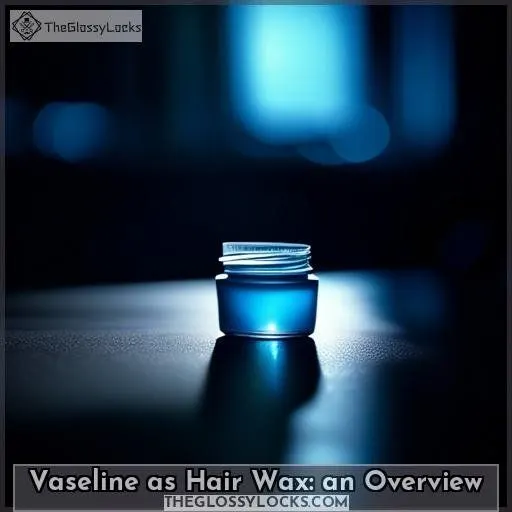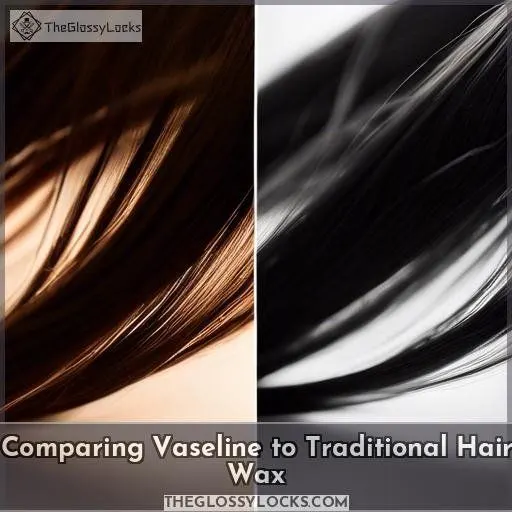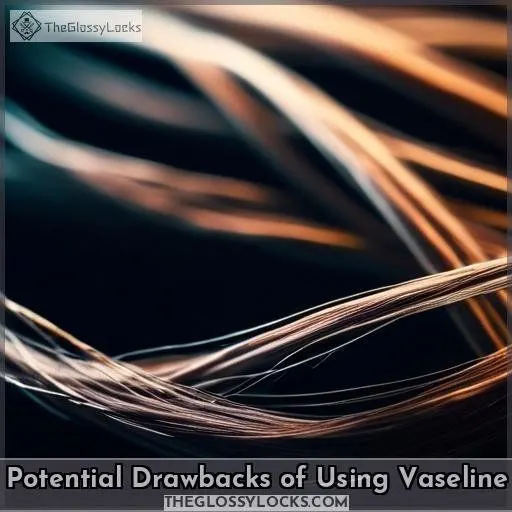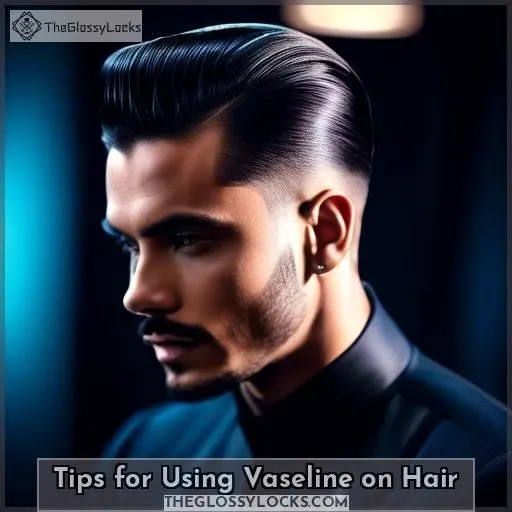This site is supported by our readers. We may earn a commission, at no cost to you, if you purchase through links.
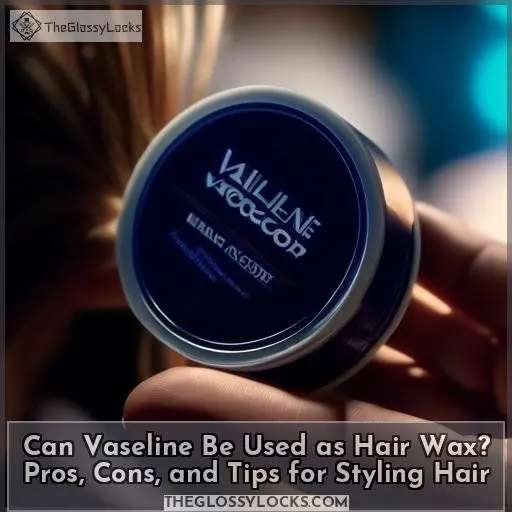 Yes, you can use Vaseline as hair wax.
Yes, you can use Vaseline as hair wax.
It provides styling capability and protects hair from environmental influences.
However, its greasy texture and consistency lack the malleability of traditional waxes.
It may not align with all hair types.
While Vaseline nourishes and smooths hair for wax application, it can also block pores and cause scalp irritation.
It can diminish hair’s natural shine.
When using Vaseline, apply a small amount to damp hair and distribute evenly.
Wash thoroughly after use to remove residue.
To fully explore the pros, cons, and tips for using Vaseline as hair wax, we’ll dive deeper.
Table Of Contents
Key Takeaways
- Vaseline can be used as a hair wax, providing styling capability and protecting hair from environmental influences.
- However, its greasy texture and potential for residue buildup may not align with all hair types and can cause scalp irritation.
- To use Vaseline as a hair wax, apply a small amount to damp hair and distribute evenly, then wash thoroughly after use.
- When compared to traditional hair waxes, Vaseline offers a slick and shiny appearance but may lack the malleability and ease of removal of dedicated hair wax products.
Can Vaseline Be Used as Hair Wax?
Yes, Vaseline can be used as a hair wax. Vaseline’s protective barrier can help lock in moisture from styling products, potentially making your hair less prone to breakage. However, it should be used sparingly and not more than once a week to avoid harming your hair.
Vaseline as Hair Wax: an Overview
Vaseline can be utilized as a hair wax, affording various advantages.
It possesses a styling capability that aids in maintaining hair in its desired position, while safeguarding it from environmental influences.
Furthermore, it can impart nourishment to hair and provide a smooth surface for wax application.
However, employing Vaseline on hair also presents certain potential disadvantages.
It may pose difficulties in removal and may not align with all hair types.
Some individuals might perceive Vaseline as imparting a greasy appearance to their hair, and it may not exhibit the same efficacy in securing hair in place as conventional hair wax products.
Should one opt to utilize Vaseline as a hair wax, meticulous application and adherence to recommended removal techniques are paramount to preclude any potential complications.
Comparing Vaseline to Traditional Hair Wax
Compared to traditional hair waxes, Vaseline offers a distinct texture and consistency – it’s greasier, lacks the malleable, pliable feel of wax products formulated for hairstyling. While Vaseline can provide some hold, traditional waxes are designed to offer superior styling capabilities, allowing you to craft and maintain intricate hairstyles with ease.
Texture and Consistency
Vaseline, a petroleum-based product, offers a unique texture and consistency compared to traditional hair wax. When applied to hair, Vaseline creates a slick and shiny appearance, which can be beneficial for those seeking to minimize frizz and add a glossy finish.
However, its thick and heavy texture may not provide the same level of hold or styling capabilities as traditional hair wax.
Additionally, Vaseline’s occlusive properties can create a barrier that may make it difficult to wash out, potentially leading to a greasy appearance.
It’s essential to use Vaseline sparingly and only when needed, as overuse can weigh hair down and make it appear oily.
Styling Capabilities
Vaseline can be used as hair wax, offering styling versatility with its hold strength. However, it may lack the scent options and shine control found in traditional hair wax. Additionally, Vaseline can provide texture variation, but it mightn’t be as easy to remove as traditional hair wax.
Ease of Removal
Regarding the removal of Vaseline from your hair, you may encounter obstacles.
The oily residue can cause hair damage, blocked pores, and product accumulation.
This can irritate the scalp and hinder thorough removal.
Regular hair wax, in contrast, is formulated for easy removal with warm water and shampoo.
Therefore, while Vaseline can be employed as a hair wax, it’s crucial to contemplate its removability and potential ramifications for your hair and scalp’s well-being.
Potential Drawbacks of Using Vaseline
While Vaseline may offer a temporary styling hold, its thick, oily texture can block pores and disrupt the natural oil production of your scalp, resulting in irritation and possible hair loss. Additionally, Vaseline is notoriously difficult to remove entirely, often leaving behind an unwanted residue that can diminish your hair’s natural shine and vibrancy.
Hair and Scalp Health Concerns
While Vaseline can slick your hair into place, it’s not all smooth sailing. Consider the flip side:
- Hair damage: Overuse may lead to weakened strands.
- Scalp irritation: Some scalps react poorly, getting itchy or flaky.
- Vaseline disadvantages: It’s a heavyweight that can suffocate your hair.
- Product alternatives: Lighter, breathable options exist that treat your hair kinder.
- Vaseline benefits: Sure, it’s a quick fix, but at what cost?
Difficulty in Washing Out
Using Vaseline as hair wax can lead to residue buildup, skin irritation, hair damage, clogged pores, and scalp dryness. The oily residue can be difficult to remove, potentially causing more harm than good. To minimize these issues, consider using a traditional hair wax or experimenting with alternative methods such as pre-waxing powders or strip wax.
Impact on Hair Appearance
Vaseline can be used as a hair wax.
However, it may not provide the styling versatility or shine control you’re looking for.
Overuse can lead to hair damage, scalp irritation, and a greasy appearance.
To use Vaseline as a hair wax, apply a small amount to your hair and style as desired.
For best results, wash your hair thoroughly after use to avoid any residue buildup.
Tips for Using Vaseline on Hair
To apply Vaseline as a hair wax, start by taking a small amount and rubbing it between your palms to slightly warm and soften it.
Then, use your fingers to distribute the petroleum jelly evenly through your hair, focusing on the areas you want to style or tame.
When removing Vaseline from your hair, you’ll need to shampoo thoroughly.
Potentially use a clarifying shampoo or add a bit of baking soda to your regular shampoo to help cut through the waxy residue.
Application Techniques
To effectively apply Vaseline as a hair wax, follow these tips:
- Choose the right amount: Start with a small amount, such as the size of a pea, and gradually add more if needed.
- Apply to damp hair: Vaseline works best on damp hair, as it can help lock in moisture and prevent breakage.
- Use a comb or brush: Gently comb or brush your hair to distribute the Vaseline evenly and avoid clumping.
- Experiment with heat activation: Some people find that heating the Vaseline slightly before application can help it spread more easily and evenly.
- Allow it to dry: After application, let the Vaseline sit for a while to allow it to absorb into your hair and set the style.
Removing Vaseline Effectively
To effectively remove Vaseline from your hair, consider these tips:
- Use a gentle shampoo: Regular shampoo may not be strong enough to break down Vaseline residue. Opt for a gentle, clarifying shampoo designed to remove build-up.
- Massage the scalp: Gently massage your scalp while shampooing to help loosen the Vaseline and prevent scalp irritation.
- Rinse thoroughly: Make sure you rinse your hair thoroughly to remove all traces of Vaseline and shampoo.
- Alternative methods: Consider using natural solutions like apple cider vinegar or baking soda to help remove Vaseline residue without damaging your hair.
- Patience: Be patient and persistent. It may take several washes to fully remove Vaseline from your hair.
Frequency of Use
After mastering the art of removing Vaseline, let’s talk frequency. Like a secret sauce, use it sparingly to avoid side effects. Overuse can bog down your hair’s natural bounce and hinder growth. Think of it as a styling technique ace up your sleeve, not your daily bread. Keep your hair’s texture in mind and let moderation lead the way.
Frequently Asked Questions (FAQs)
Can Vaseline be used as a hair wax?
You can certainly use Vaseline as a hair wax, my friend. It provides a decent hold and shine, though the greasy texture might feel heavy for some. Consider mixing it with beeswax for a more natural, pliable styling product.
What are the benefits of using Vaseline on hair?
You’ve hit the holy grail! Vaseline’s shine adds luster, its oils lock in moisture, and its consistency gives you pliable yet firm hold. Just be mindful of potential greasiness and buildup – moderation is key.
How does Vaseline compare to traditional hair wax?
Did you know that 33% of men use hair wax? Unlike wax, Vaseline won’t give you that strong, pliable hold – it’s more of a softening agent. But hey, if a natural shine is what you’re after, a dab of Vaseline could be your new secret weapon.
What are the potential drawbacks of using Vaseline on hair?
Sure, Vaseline’s greasy texture can weigh down hair, causing it to look limp and lifeless. It may also attract dirt and dust, leading to an unkempt appearance. Opt for lightweight, hair-specific products instead for a polished, healthy look.
How can Vaseline be used to style hair?
You can melt Vaseline and mix it with beeswax to create a DIY styling wax. Heat it, apply evenly, and style your ‘do. Just don’t overdo it – a little goes a long way!
Conclusion
Ultimately, while you can utilize Vaseline as a hair wax replacement, it may not be the most suitable option for all hair types or styling requirements.
Its oily texture and potential for causing residue or scalp irritation should be balanced against its ability to control frizz and provide minimal hold.
If utilizing Vaseline, follow appropriate application and removal techniques, and limit frequency to mitigate potential adverse effects.
Assessing the advantages and disadvantages will assist in determining if using Vaseline as a hair wax substitute aligns with your hair’s requirements and desired outcomes.

